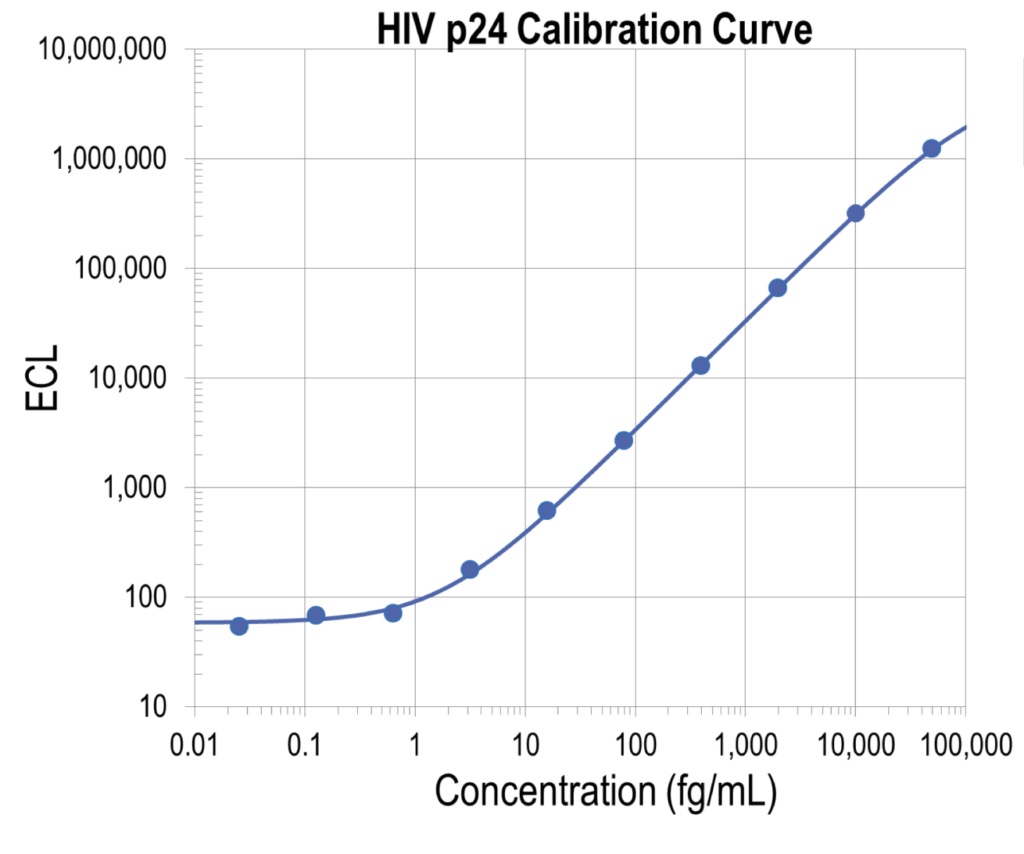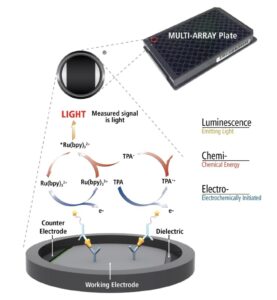Mesoscale Diagnostics
This post previously appeared on the substack.
I initially came across Mesoscale when looking at Quanterix. Like Quanterix, Mesoscale make very high sensitivity claims for their immunoassay, in the fg/ml range. Mesoscale Diagnostics has also been around for much longer that Quanterix having been founded in 1995. They are reported to have an annual revenue of ~$100M.
In particular I came across Mesoscale, because they show very 1 fg/ml sensitivity on HIV p24:

These results are similar to the 1 fg/ml results shown by Quanterix, which suggest that Quanterix is not unique in their sensitivity claims.

The Mesoscale approach uses electrochemiluminescence (ECL) to detect antibodies. Here we’re electrically initiating a chemical reaction which will emit light. We can imagine this has certain advantages over fluorescence. In particular we don’t have any background fluorescence to deal with, or any excitation illumination to filter. ECL has in fact been using for single molecule super-resolution imaging. Though I imagine that with each reaction only emitting a single photon, the advantage of this over other super resolution approaches is limited.
If you’re familiar with Roche’s Cobas e411 and this all sounds somewhat familiar that’s probably because they use the same basic approach. Mesoscale successfully sued Roche for infringing their patents in a legal situation that seems both fascinating and horribly complex.
Interestingly, there’s a teardown of a Mesoscale instrument on YouTube. The instrument uses a fairly typical 2000s vintage Princeton/Roper cooled CCD camera with 20 micron pixels. Comments on this video were also fascinating, indicating the the plates cost ~$1000. As these plates require embedded electrodes, we would expect them to be a high cost consumable. But this still seems rather expensive…
Comments also suggest that “multiple competitors…can outperform and do assays cheaper” and “Bio-rad’s multiplex Elisa is pretty much as good”. The Bio-rad kits I could find however only report sensitivity down to ~5pg/mL on HIV p24 which is an order of magnitude worse than Mesoscale. But of course for many other assay’s like Quanterix the sensitivity is likely limited by available antibodies in any case.
For the most part I was interested in looking at Mesoscale to see how unique Quanterix/Simoa is. In terms of raw sensitivity, Quanterix does not appear to be unique. Mesoscale platform is showing similar single digit fg/ml sensitivity. The Roche Cobas e411 p24 assay also gets close, with sensitivity in the 60 fg/ml range.
It seems likely that Quanterix has a cost advantage over Mesoscale. But Cobas e411 tests in the range of $20 appear to be available. It’s therefore possible that Quanterix may still have an advantage here if they can show very high sensitivity at low cost.